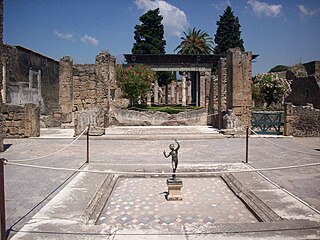 W
WThe House of the Centenary was the house of a wealthy resident of Pompeii, preserved by the eruption of Mount Vesuvius in 79 AD. The house was discovered in 1879, and was given its modern name to mark the 18th centenary of the disaster. Built in the mid-2nd century BC, it is among the largest houses in the city, with private baths, a nymphaeum, a fish pond (piscina), and two atria. The Centenary underwent a remodeling around 15 AD, at which time the bath complex and swimming pool were added. In the last years before the eruption, several rooms had been extensively redecorated with a number of paintings.
 W
WThe House of the Faun, built during the 2nd century BC, was one of the largest and most impressive private residences in Pompeii, Italy, and housed many great pieces of art. It is one of the most luxurious aristocratic houses from the Roman republic, and reflects this period better than most archaeological evidence found even in Rome itself.
 W
WThe House of Julia Felix, also referred to as the praedia of Julia Felix, is a large Roman property on the Via dell'Abbondanza in the city of Pompeii. It was originally the residence of Julia Felix, who converted portions of it to apartments available for rent and other parts for public use after the major earthquake in 62 AD, a precursor to the eruption of Mount Vesuvius in 79 AD that destroyed Pompeii.
 W
WThe House of Loreius Tiburtinus is renowned for its meticulous and well-preserved artwork as well as its large gardens.
 W
WThe House of Menander is one of the richest and most magnificent houses in ancient Pompeii in terms of architecture, decoration and contents, and covers a large area of about 1,800 square metres (19,000 sq ft). Its quality means the owner must have been an aristocrat involved in politics, with great taste for art. Mussolini held a lunch party in Room 18 when he visited Pompeii in 1940.
 W
WThe House of Sallust is a domus or elite residence in the ancient Roman city of Pompeii. The oldest parts of the house have been dated to the 4th century BCE, but the main expansions were built in the 2nd century BCE during the Roman period. The long history of this structure provides important evidence about the development of elite residences in Pompeii. The house is located on the east side of the Via Consolare. It received its modern name from an election notice placed on the facade, recommending Gaius Sallustius for office. An alternative name is the House of A. Cossus Libanus, from a seal found in the ruins. The site was later damaged by a bomb in World War II, and was restored in 1970.
 W
WThe House of the Silver Wedding is the name given to the archaeological remains of a Roman house in Pompeii, buried in the ash from the 79 AD eruption of Mount Vesuvius. The house was excavated in 1893 and was named after the silver wedding anniversary of Umberto and Margherita of Savoy which took place in that year.
 W
WThe House of the surgeon is the oldest and one of the most famous houses in Pompeii, which is located in the Italian region of Campania. It is named after ancient surgical instruments that were found there. It was destroyed by the AD 79 eruption of Mount Vesuvius, and uncovered in 1770 by Frances La Vega, (Spain). The house today still stands partially and it is open for tourists to see.
 W
WThe House of the Tragic Poet is a Roman house in Pompeii, Italy dating to the 2nd century BC. The house is famous for its elaborate mosaic floors and frescoes depicting scenes from Greek mythology.
 W
WThe House of the Vettii is a domus located in the Roman town, Pompeii, which was preserved by the eruption of Mount Vesuvius in 79 AD. The house is named for its owners, two successful freedmen: Aulus Vettius Conviva, an Augustalis, and Aulus Vettius Restitutus. Its careful excavation has preserved almost all of the wall frescos, which were completed following the earthquake of 62 AD, in the manner art historians term the Pompeiian Fourth Style. The House of Vetti is located in region VI, near the Vesuvian Gate, bordered by the Vicolo di Mercurio and the Vicolo dei Vettii. The house is one of the largest domus in Pompeii, spanning the entire southern section of block 15. The plan is fashioned in a typical Roman domus with the exception of a tablinum, which is not included. There are twelve mythological scenes across four cubiculum and one triclinium.
 W
WThe House of the Prince of Naples is a Roman townhouse located in Region VI, Insula XV, entrances 7 and 8 in the archaeological site of Pompeii near Naples, Italy. The structure is so named because the Prince and Princess of Naples Joseph Bonapartes grandson Louis Joseph and his wife Laura, attended a ceremonial excavation of selected rooms there on March 22, 1898. The house is painted throughout in the Pompeian Fourth Style and is valued by scholars because its decoration is all of a single style and single period, unlike many surviving Roman structures that are found to be a hodgepodge of styles from different periods.